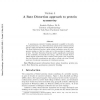Free Online Productivity Tools
i2Speak
i2Symbol
i2OCR
iTex2Img
iWeb2Print
iWeb2Shot
i2Type
iPdf2Split
iPdf2Merge
i2Bopomofo
i2Arabic
i2Style
i2Image
i2PDF
iLatex2Rtf
Sci2ools
105
click to vote
BIOSYSTEMS
2010
2010
A rate distortion approach to protein symmetry
A spontaneous symmetry breaking argument is applied to the problem of protein form, via a Rate Distortion analysis of the relation between genome coding and the final condensation of the protein `molten globule'. The Rate Distortion Function, under coding constraints, serves as a temperature analog, so that low values act to drive proteins to simple symmetries. The Rate Distortion Function itself is significantly constrained by the availability of metabolic free energy. This work extends Tlusty's (2007) elegant exploration of the evolution of the genetic code, suggesting that rate distortion considerations may play a critical role across a broad spectrum of molecular expressions of evolutionary process. Key Words groupoid, information theory, phase transition, protein symmetry, Rate Distortion, spontaneous symmetry breaking
| Added | 08 Dec 2010 |
| Updated | 08 Dec 2010 |
| Type | Journal |
| Year | 2010 |
| Where | BIOSYSTEMS |
| Authors | Rodrick Wallace |
Comments (0)

